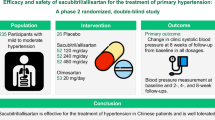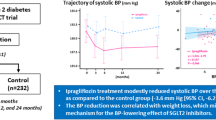Abstract
Metabolic syndrome, a cluster of risk factors that increase the risk of cardiovascular morbidity and mortality, is common in patients with hypertension. Chronic renin–angiotensin–aldosterone system (RAAS) activation, shown by elevated plasma renin activity (PRA), is implicated in many of the features of metabolic syndrome. The direct renin inhibitor aliskiren may be of benefit in this patient group as aliskiren targets the RAAS at the rate-limiting step. In this double-blind study, 141 patients with hypertension (mean baseline BP 155/93 mm Hg) and metabolic syndrome (modified National Cholesterol Education Program ATP III criteria) were randomized to aliskiren 300 mg or irbesartan 300 mg once daily. Patients treated with aliskiren 300 mg had their mean sitting blood pressure (BP) lowered by 13.8/7.1 mm Hg after 12 weeks, significantly greater (P⩽0.001) than the 5.8/2.8 mm Hg reduction observed in patients treated with irbesartan 300 mg. A significantly greater proportion of patients treated with aliskiren achieved BP control to <135/85 mm Hg (29.2 vs 16.7% with irbesartan; P=0.019). Aliskiren treatment led to a 60% decrease in PRA from baseline, whereas irbesartan increased PRA by 99% (both P<0.001). Aliskiren and irbesartan had similar effects on glucose and lipid profiles and on a panel of biomarkers of inflammation and cardiovascular risk. Both aliskiren and irbesartan were well tolerated. Collectively, these results suggest that aliskiren 300 mg may offer treatment benefits compared with irbesartan 300 mg for BP reduction in patients with hypertension and metabolic syndrome.
This is a preview of subscription content, access via your institution
Access options
Subscribe to this journal
Receive 12 digital issues and online access to articles
$119.00 per year
only $9.92 per issue
Buy this article
- Purchase on Springer Link
- Instant access to full article PDF
Prices may be subject to local taxes which are calculated during checkout



Similar content being viewed by others
References
Schillaci G, Pirro M, Vaudo G, Gemelli F, Marchesi S, Porcellati C et al. Prognostic value of the metabolic syndrome in essential hypertension. J Am Coll Cardiol 2004; 43: 1817–1822.
Cuspidi C, Meani S, Fusi V, Severgnini B, Valerio C, Catini E et al. Metabolic syndrome and target organ damage in untreated essential hypertensives. J Hypertens 2004; 22: 1991–1998.
NCEP. Executive Summary of The Third Report of The National Cholesterol Education Program (NCEP) Expert Panel on Detection, Evaluation, and Treatment of High Blood Cholesterol In Adults (Adult Treatment Panel III). JAMA 2001; 285: 2486–2497.
Ratto E, Leoncini G, Viazzi F, Vaccaro V, Parodi A, Falqui V et al. Metabolic syndrome and cardiovascular risk in primary hypertension. J Am Soc Nephrol 2006; 17: S120–S122.
Engeli S, Schling P, Gorzelniak K, Boschmann M, Janke J, Ailhaud G et al. The adipose-tissue renin–angiotensin–aldosterone system: role in the metabolic syndrome? Int J Biochem Cell Biol 2003; 35: 807–825.
Prasad A, Quyyumi AA . Renin–angiotensin system and angiotensin receptor blockers in the metabolic syndrome. Circulation 2004; 110: 1507–1512.
Engeli S, Gorzelniak K, Kreutz R, Runkel N, Distler A, Sharma AM . Co-expression of renin–angiotensin system genes in human adipose tissue. J Hypertens 1999; 17: 555–560.
Mancia G, De Backer G, Dominiczak A, Cifkova R, Fagard R, Germano G et al. 2007 Guidelines for the management of arterial hypertension: the Task Force for the Management of Arterial Hypertension of the European Society of Hypertension (ESH) and of the European Society of Cardiology (ESC). J Hypertens 2007; 25: 1105–1187.
Schmieder RE, Ruilope LM . Blood pressure control in patients with comorbidities. J Clin Hypertens (Greenwich) 2008; 10: 624–631.
Frampton JE, Curran MP . Aliskiren: a review of its use in the management of hypertension. Drugs 2007; 67: 1767–1792.
Azizi M, Webb R, Nussberger J, Hollenberg NK . Renin inhibition with aliskiren: where are we now, and where are we going? J Hypertens 2006; 24: 243–256.
Bair TL, May HT, Prescott MF, Anderson JL, Horne BD, Penman J et al. Association between baseline levels of plasma renin activity and risk of cardiovascular events. J Am Coll Cardiol 2009: A383, 1028-12.
Vergaro G, Fontana M, Poletti R, Giannoni A, Iervasi AL, Masi L et al. Plasma renin activity is an independent prognostic factor in chronic heart failure. Eur Heart J 2008; 29 (Suppl 1): 393 (Abstract: 2493).
Rouleau JL, Packer M, Moye L, de Champlain J, Bichet D, Klein M et al. Prognostic value of neurohumoral activation in patients with an acute myocardial infarction: effect of captopril. J Am Coll Cardiol 1994; 24: 583–591.
Schmieder RE, Philipp T, Guerediaga J, Gorostidi M, Bush C, Keefe DL . Aliskiren-based therapy lowers blood pressure more effectively than hydrochlorothiazide-based therapy in obese patients with hypertension: sub-analysis of a 52-week, randomized, double-blind trial. J Hypertens 2009; 27: 1493–1501.
Jordan J, Engeli S, Boye SW, Le Breton S, Keefe DL . Direct renin inhibition with aliskiren in obese patients with arterial hypertension. Hypertension 2007; 49: 1047–1055.
Prescott MF, Boye SW, Le Breton S, Keefe DL, Jordan J . Antihypertensive efficacy, safety and tolerability of the orally active direct renin inhibitor aliskiren added to hydrochlorothiazide (HCTZ) in patients with grade 3 obesity and hypertension. Int J Obes 2007; 31: S99 T2:PO.88.
White WB, Anderson DR, Arora V, Bush C, Keefe DL . Antihypertensive effectiveness of the direct renin inhibitor aliskiren in patients with metabolic syndrome: a comparative analysis of 7219 patients from 10 randomized trials. Eur Heart J 2007; 28: 868 P4845.
American Heart Association. Recommendations for human blood pressure determination by sphygmomanometers. Circulation 1988; 77: 501A–514A.
Nussberger J, Fasanella d’Amore T, Porchet M, Waeber B, Brunner DB, Brunner HR et al. Repeated administration of the converting enzyme inhibitor cilazapril to normal volunteers. J Cardiovasc Pharmacol 1987; 9: 39–44.
Liu MY, Xydakis AM, Hoogeveen RC, Jones PH, Smith EO, Nelson KW et al. Multiplexed analysis of biomarkers related to obesity and the metabolic syndrome in human plasma, using the Luminex-100 system. Clin Chem 2005; 51: 1102–1109.
Fliser D, Buchholz K, Haller H . Antiinflammatory effects of angiotensin II subtype 1 receptor blockade in hypertensive patients with microinflammation. Circulation 2004; 110: 1103–1107.
Lithell HO . Effect of antihypertensive drugs on insulin, glucose, and lipid metabolism. Diabetes Care 1991; 14: 203–209.
Yarows SA, Oparil S, Patel S, Arora V, Zhang J . Aliskiren in combination with valsartan lowers blood pressure more effectively than either agent alone in patients with hypertension, regardless of metabolic status: a post-hoc analysis of an 8-week double-blind study. Diabetologia 2008; 51: S493.
Sarzani R, Salvi F, Dessi-Fulgheri P, Rappelli A . Renin–angiotensin system, natriuretic peptides, obesity, metabolic syndrome, and hypertension: an integrated view in humans. J Hypertens 2008; 26: 831–843.
Nussberger J, Gradman AH, Schmieder RE, Lins RL, Chiang Y, Prescott MF . Plasma renin and the antihypertensive effect of the orally active renin inhibitor aliskiren in clinical hypertension. Int J Clin Pract 2007; 61: 1461–1468.
Menard J, Guyene TT, Peyrard S, Azizi M . Conformational changes in prorenin during renin inhibition in vitro and in vivo. J Hypertens 2006; 24: 529–534.
Batenburg WW, de Bruin RJ, van Gool JM, Muller DN, Bader M, Nguyen G et al. Aliskiren-binding increases the half life of renin and prorenin in rat aortic vascular smooth muscle cells. Arterioscler Thromb Vasc Biol 2008; 28: 1151–1157.
Schalekamp MA, Derkx FH, Deinum J, Danser AJ . Newly developed renin and prorenin assays and the clinical evaluation of renin inhibitors. J Hypertens 2008; 26: 928–937.
Toffelmire EB, Slater K, Corvol P, Menard J, Schambelan M . Response of plasma prorenin and active renin to chronic and acute alterations of renin secretion in normal humans. Studies using a direct immunoradiometric assay. J Clin Invest 1989; 83: 679–687.
Jose PJ, Griffiths-Johnson DA, Collins PD, Walsh DT, Moqbel R, Totty NF et al. Eotaxin: a potent eosinophil chemoattractant cytokine detected in a guinea pig model of allergic airways inflammation. J Exp Med 1994; 179: 881–887.
Flammer AJ, Hermann F, Wiesli P, Schwegler B, Chenevard R, Hurlimann D et al. Effect of losartan, compared with atenolol, on endothelial function and oxidative stress in patients with type 2 diabetes and hypertension. J Hypertens 2007; 25: 785–791.
Kathiresan S, Gona P, Larson MG, Vita JA, Mitchell GF, Tofler GH et al. Cross-sectional relations of multiple biomarkers from distinct biological pathways to brachial artery endothelial function. Circulation 2006; 113: 938–945.
Acknowledgements
WK, MB, IR, MF, C-MY and WPD participated in the design of the original study and approval of the final protocol. All authors were involved in the collection, analysis and interpretation of the data, and in the writing of the article, and approved the final version. The authors take full responsibility for the content of the paper but thank Dr Richard White (Oxford PharmaGenesis Ltd) for medical writing support, editorial assistance, and collation and incorporation of comments from all authors. This work was funded by Novartis Pharmaceuticals Corporation, East Hanover, NJ, USA. A full list of investigators can be found in the Appendix.
Author information
Authors and Affiliations
Corresponding author
Ethics declarations
Competing interests
WK has received honoraria from MSD Sharp & Dohme, Takeda, Sanofi, Daiichi Sankyo, and has an advisory board relationship with MSD Sharp & Dohme and a research grant from Bayer Healthcare. MB and IR (Novartis Institutes for Biomedical Research, Basel, Switzerland), C-MY and MFP (Novartis Pharmaceuticals Corporation, East Hanover, NJ, USA) and WPD (Novartis Institutes for Biomedical Research Inc., Cambridge, MA, USA) are employees of Novartis and are therefore eligible for Novartis stock and stock options. MH, H-FM and TJ declare no conflicts of interest.
Appendix
Appendix
List of investigators
Mathias Böhme (Dresden), Gerald Eckhardt (Leipzig), Andreas Haack (Schauenburg), Markolf Hanefeld (Dresden), Uwe Jorns (Trossingen), Thomas Jung (Deggingen), Michael Klamm (Neuhofen), Wilhelm Krone (Köln), Peter Krupp (Bad Zwischenahn), Anja Leker (Greven), Marco Loddo (Rastede), Marion Mielke (Berlin), Hans-Friedrich Meyer (Marl), Ingomar FK Naudts (Rodgau), Gerhard Neumann (Delitzsch), Ulrich Poser (Leipzig), Matthias Remppis (Weissenhorn), Andreas Schreckenberg (Weyhe), Bastian Steinberg (Hamburg), Joachim Weimer (Reinfeld), Bernhard Winkelmann (Frankfurt-Sachsenhausen), Hans-Hermann Zimny (Bad Pyrmont), Angelika Zscherpe (Leipzig).
Rights and permissions
About this article
Cite this article
Krone, W., Hanefeld, M., Meyer, HF. et al. Comparative efficacy and safety of aliskiren and irbesartan in patients with hypertension and metabolic syndrome. J Hum Hypertens 25, 186–195 (2011). https://doi.org/10.1038/jhh.2010.38
Received:
Revised:
Accepted:
Published:
Issue Date:
DOI: https://doi.org/10.1038/jhh.2010.38
Keywords
This article is cited by
-
The role of aliskiren in the management of hypertension and major cardiovascular outcomes: a systematic review and meta-analysis
Journal of Human Hypertension (2019)
-
Effect of aldosterone breakthrough on albuminuria during treatment with a direct renin inhibitor and combined effect with a mineralocorticoid receptor antagonist
Hypertension Research (2013)
-
Effectiveness and Safety of Aliskiren and Aliskiren Hydrochlorothiazide (HCT) in a Multiethnic, Real-World Setting
Advances in Therapy (2013)



